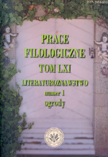Ikonografia ogrodów symbolizmu rosyjskiego. Bez
Iconography of the Gardens of Russian Symbolism. Lilac
Author(s): Izabella MalejSubject(s): Literary Texts
Published by: Wydział Polonistyki Uniwersytetu Warszawskiego
Keywords: ogród; ikonografia; symbolizm rosyjski; bez; garden; iconography; Russian Symbolism; lilac
Summary/Abstract: Lilac has been the symbol of Russian gardens for ages, gradually becoming their inseparable attribute. The Russian word ‘сирень’ (lilac) is derived from Greek ‘syrinx’ meaning a pipe (musical instrument). This name has also its own mythic explanation of double i.e. Greek and Scandinavian origin. Since the 19th century lilac has been attracting attention of many Russian poets and painters, becoming the source of their inspiration. The most eminent painter of lilac is Mikhail Vrubel, whose “portraits” of lilac: {Lilac bush} ({Куст сирени}, 1900) and {Lilac} ({Сирень}, 1900 and 1901) are magical, ambiguous and stunning with their enchanting, iridescent colours and the atmosphere of mystery. Vrubel gives his paintings a profound philosophical meaning playing with the ambivalence of his subject. This subject is the transformation of Chaos into Cosmos. The same attitude can be observed in the poems of A. Blok, K. Balmont, I. Annenski. In each of the iconic representations of lilac analysed by the author of this article, lilac obtains the status of a symbol as an artistic sign with a complex semantic structure and definite, melancholically sensual emotional quality. In this way lilac becomes an iconic announcement with a multi-level structure for Russian symbolists. The process of perception of poetry and paintings becomes the way {a realibus ad realiora}, from matter to feeling. It leads to the conclusion that Russian artists of the turn of the 19th and 20th centuries saw in lilac the sign of a higher, better world, where all its elements (real, mystic, mythic and fantastic) coexist, the sign of yearning for the idea of harmony.
Journal: Prace Filologiczne. Literaturoznawstwo [PFLIT]
- Issue Year: 2011
- Issue No: 1 (4)
- Page Range: 135-155
- Page Count: 21
- Language: Polish

